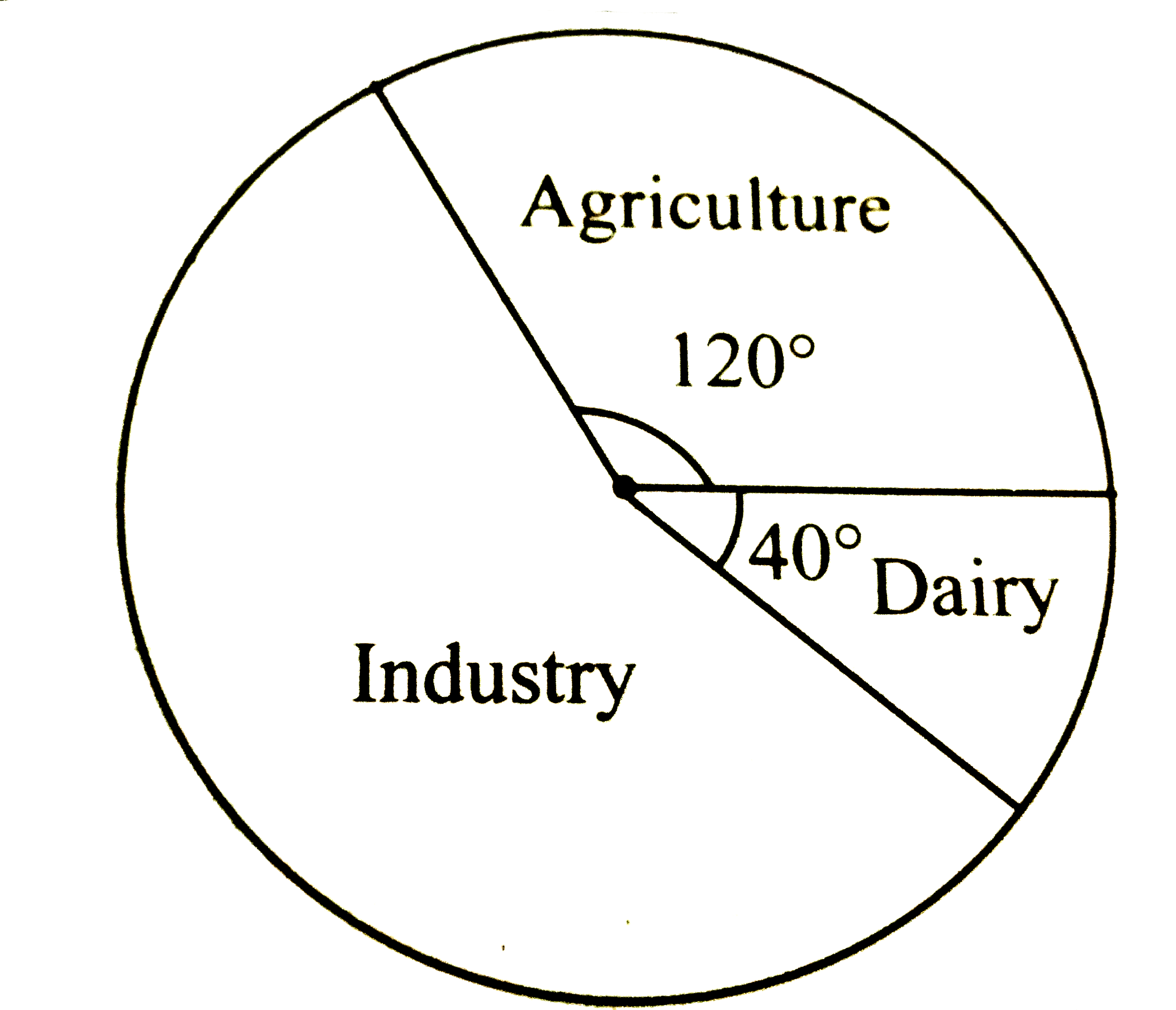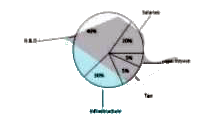Micro Credit means :
1. Loans of small amount to people in unorganised sector
2. Loans to Self-Help Groups
3. Loans amounting Rs 50 lakhs to Rs 5 crores to Medium and Small Industrial Units.
Only 1
Only 2
Only 1 and 2
All 1, 2 and 3
The correct Answer is:C
Step by step video, text & image solution for Micro Credit means : 1. Loans of small amount to people in unorganised sector 2. Loans to Self-Help Groups 3. Loans amounting Rs 50 lakhs to Rs 5 crores to Medium and Small Industrial Units. by General Knowledge experts to help you in doubts & scoring excellent marks in Class 14 exams.
Updated on:21/07/2023Similar Questions
The following pie diagram represents the sectorwise loan amount in crores of rupees distributied by a bank. From the information answer the following questions:
i. If the dairy sector receives Rs20 crores, then find the total loan disbursed.
ii. Find the loan amount for agriculture sector and also for idustrial sector.
iii How much additional amount did industrial sector receive than agriculture sector?

View SolutionBanks use the major portion of the deposits to extend loans. There is a huge demand for loans for various economic activities. Banks make use of the deposits to meet the loan requirements of the people. In this way, banks mediate between those who have surplus funds (the depositors) and those who are in need of these funds (the borrowers). Banks charge a higher interest rate on loans than what they offer on deposits. A large number of transactions in our day-to-day activities involve credit in some form or the other. Credit (loan) refers to an agreement in which the lender supplies the borrower with money, goods or services in return for the promise of future payment. In rural areas, the main demand for credit is for crop production, Crop production involves considerable costs on seeds, fertilisers, pesticides, water, electricity, repair of equipment, etc.
The various types of loans can be conveniently grouped as formal sector loans and informal sector loans. Among the former are loans from banks and cooperatives. The informal lenders include moneylenders, traders, employers, relatives and friends, etc. The Reserve Bank of India supervises the functioning of formal sources of loans. For instance, we have seen that the banks maintain a minimum cash balance out of the deposits they receive. The RBI monitors the banks in actually maintaining cash balance. There is no organisation which supervises the credit activities of lenders in the informal sector. They can lend at whatever interest rate they choose. There is no one to stop them from using unfair means to get their money back. Compared to the formal lenders, most of the informal lenders charge a much higher interest on loans. Thus, the cost to the borrower of informal loans is much higher. In recent years, people have tried out some newer ways of providing loans to the poor. The idea is to organise rural poor, in particular women, into small Self-Help Groups (SHGs) and pool (collect) their savings.
Answer the following MCQs by choosing the most appropriate option
Formal sector loans include loans from
(I) Banks
(II) Moneylenders
(III) Cooperatives
(IV) Traders
View Solution
Knowledge Check
Loans of very small amount given to low income groups is called.
ACash creditBMirco creditCSimple overdraftDNo frills loansWhat is the limit for housing loans under priority sector ?
1. Loans to individuals up to 28 lakh in metropolitan centers
2. Loans up to 20 lakh in other centres for purchase/ construction of a dwelling unit per family,
3. Loans to individuals up to 40 Lakh in metropolitan centres.A1.Only 1B2.Only 2C3.Only 3D4.1 and 2 bothA lends a loan amount of Rs 2,50,000 to B at the simple interest of 6% per annum for a year. What is the total amount (in Rs) of interest paid by B ?
A15,000B16,500C12,000D52,500
Statement: The govt has recently advised all the public sector banks to reduce rate of interest on home loans upto Rs.25 lakhs.
Assumptions: I. The public sector banks may reduce the interest on all home loans upto Rs. 25 lakhs.
II. People may take undue advantage of the govt.'s decision.
View SolutionBanks use the major portion of the deposits to extend loans. There is a huge demand for loans for various economic activities. Banks make use of the deposits to meet the loan requirements of the people. In this way, banks mediate between those who have surplus funds (the depositors) and those who are in need of these funds (the borrowers). Banks charge a higher interest rate on loans than what they offer on deposits. A large number of transactions in our day-to-day activities involve credit in some form or the other. Credit (loan) refers to an agreement in which the lender supplies the borrower with money, goods or services in return for the promise of future payment. In rural areas, the main demand for credit is for crop production, Crop production involves considerable costs on seeds, fertilisers, pesticides, water, electricity, repair of equipment, etc.
The various types of loans can be conveniently grouped as formal sector loans and informal sector loans. Among the former are loans from banks and cooperatives. The informal lenders include moneylenders, traders, employers, relatives and friends, etc. The Reserve Bank of India supervises the functioning of formal sources of loans. For instance, we have seen that the banks maintain a minimum cash balance out of the deposits they receive. The RBI monitors the banks in actually maintaining cash balance. There is no organisation which supervises the credit activities of lenders in the informal sector. They can lend at whatever interest rate they choose. There is no one to stop them from using unfair means to get their money back. Compared to the formal lenders, most of the informal lenders charge a much higher interest on loans. Thus, the cost to the borrower of informal loans is much higher. In recent years, people have tried out some newer ways of providing loans to the poor. The idea is to organise rural poor, in particular women, into small Self-Help Groups (SHGs) and pool (collect) their savings.
Answer the following MCQs by choosing the most appropriate option
Compared to the formal lenders, most of the informal lenders charge a much............. interest on loans
View SolutionBanks use the major portion of the deposits to extend loans. There is a huge demand for loans for various economic activities. Banks make use of the deposits to meet the loan requirements of the people. In this way, banks mediate between those who have surplus funds (the depositors) and those who are in need of these funds (the borrowers). Banks charge a higher interest rate on loans than what they offer on deposits. A large number of transactions in our day-to-day activities involve credit in some form or the other. Credit (loan) refers to an agreement in which the lender supplies the borrower with money, goods or services in return for the promise of future payment. In rural areas, the main demand for credit is for crop production, Crop production involves considerable costs on seeds, fertilisers, pesticides, water, electricity, repair of equipment, etc.
The various types of loans can be conveniently grouped as formal sector loans and informal sector loans. Among the former are loans from banks and cooperatives. The informal lenders include moneylenders, traders, employers, relatives and friends, etc. The Reserve Bank of India supervises the functioning of formal sources of loans. For instance, we have seen that the banks maintain a minimum cash balance out of the deposits they receive. The RBI monitors the banks in actually maintaining cash balance. There is no organisation which supervises the credit activities of lenders in the informal sector. They can lend at whatever interest rate they choose. There is no one to stop them from using unfair means to get their money back. Compared to the formal lenders, most of the informal lenders charge a much higher interest on loans. Thus, the cost to the borrower of informal loans is much higher. In recent years, people have tried out some newer ways of providing loans to the poor. The idea is to organise rural poor, in particular women, into small Self-Help Groups (SHGs) and pool (collect) their savings.
Answer the following MCQs by choosing the most appropriate option
An agreement in which the lender supplies the borrower with money, goods or services in return for the promise of future payment.
View SolutionBanks use the major portion of the deposits to extend loans. There is a huge demand for loans for various economic activities. Banks make use of the deposits to meet the loan requirements of the people. In this way, banks mediate between those who have surplus funds (the depositors) and those who are in need of these funds (the borrowers). Banks charge a higher interest rate on loans than what they offer on deposits. A large number of transactions in our day-to-day activities involve credit in some form or the other. Credit (loan) refers to an agreement in which the lender supplies the borrower with money, goods or services in return for the promise of future payment. In rural areas, the main demand for credit is for crop production, Crop production involves considerable costs on seeds, fertilisers, pesticides, water, electricity, repair of equipment, etc.
The various types of loans can be conveniently grouped as formal sector loans and informal sector loans. Among the former are loans from banks and cooperatives. The informal lenders include moneylenders, traders, employers, relatives and friends, etc. The Reserve Bank of India supervises the functioning of formal sources of loans. For instance, we have seen that the banks maintain a minimum cash balance out of the deposits they receive. The RBI monitors the banks in actually maintaining cash balance. There is no organisation which supervises the credit activities of lenders in the informal sector. They can lend at whatever interest rate they choose. There is no one to stop them from using unfair means to get their money back. Compared to the formal lenders, most of the informal lenders charge a much higher interest on loans. Thus, the cost to the borrower of informal loans is much higher. In recent years, people have tried out some newer ways of providing loans to the poor. The idea is to organise rural poor, in particular women, into small Self-Help Groups (SHGs) and pool (collect) their savings.
Answer the following MCQs by choosing the most appropriate option
Banks use the major portion of the deposits to
View SolutionStudy the following pie chart and answer the question that follows
The pie chart shows company XYZ expenditure on various heads for Q3 2015.

If the company the spent a total of Rs 120 lakhs crores on the various heads, then how much was spent on loan interest
View Solution
